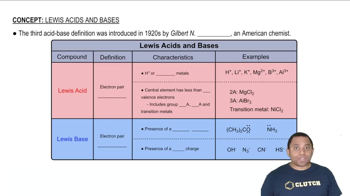Tartaric acid, H2C4H4O6, has two acidic hydrogens. The acid is often present in wines, and a salt derived from the acid precipitates from solution as the wine ages. A solution containing an unknown concentration of the acid is titrated with NaOH. It requires 24.65 mL of 0.2500 M NaOH solution to titrate both acidic protons in 50.00 mL of the tartaric acid solution. Write a balanced net ionic equation for the neutralization reaction
A solid sample of Zn(OH)2 is added to 0.350 L of 0.500 M aqueous HBr. The solution that remains is still acidic. It is then titrated with 0.500 M NaOH solution, and it takes 88.5 mL of the NaOH solution to reach the equivalence point. What mass of Zn(OH)2 was added to the HBr solution?
 Verified step by step guidance
Verified step by step guidance
Verified video answer for a similar problem:
Key Concepts
Acid-Base Neutralization

Stoichiometry

Molar Mass

Tartaric acid, H2C4H4O6, has two acidic hydrogens. The acid is often present in wines, and a salt derived from the acid precipitates from solution as the wine ages. A solution containing an unknown concentration of the acid is titrated with NaOH. It requires 24.65 mL of 0.2500 M NaOH solution to titrate both acidic protons in 50.00 mL of the tartaric acid solution. Calculate the molarity of the tartaric acid solution.
If 23.9 mL of the strontium hydroxide solution was needed to neutralize a 37.5 mL aliquot of the nitric acid solution, what is the concentration (molarity) of the acid?
Suppose you have 5.00 g of powdered magnesium metal, 1.00 L of 2.00 M potassium nitrate solution, and 1.00 L of 2.00 M silver nitrate solution. d. What is the molarity of the Mg2+ ions in the resulting solution?
(a) By titration, 15.0 mL of 0.1008 M sodium hydroxide is needed to neutralize a 0.2053-g sample of a weak acid. What is the molar mass of the acid if it is monoprotic?
(b) An elemental analysis of the acid indicates that it is composed of 5.89% H, 70.6% C, and 23.5% O by mass. What is its molecular formula?
